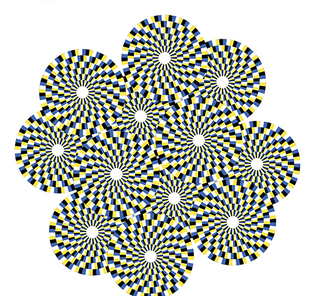
Optical illusions may seem like mere internet curiosities. But humans aren’t the only ones who respond to them: at least one illusion can confuse cats, for example. Now, Yale researchers have found optical illusions that mislead fruit flies.
Fruit flies and humans are, strictly speaking, related. But their ancestors diverged many hundreds of millions of years ago—so long ago, says Yale neuroscientist Damon Clark, that “the fact that they would be susceptible to the same illusions is surprising. We think these illusions can give us some special insights into how the visual system works.”
One such optical illusion (shown here) consists of concentric circles containing areas that shade from black to white. Though it’s a static image, humans perceive it to rotate to the right (clockwise). Clark demonstrated that fruit flies see that rotation, too. His team tethered the creatures to tiny, treadmill-like spheres, and then showed them the image. The flies reacted just as they would react to actual rotation: they turned to the right, the direction of the illusory motion.
Next, the researchers figured out how two types of fruit-fly neurons, rightward selective T4s and leftward selective T5s, work to produce the illusion. When Clark’s team silenced the T4s with genetic tools, the flies turned left, reversing the perception error. That experiment showed that T4s are more influential than T5s. And when researchers silenced the T5s and left the T4s in place, the illusion was magnified: the flies turned faster to the right. The team then checked whether humans have a similar imbalance. They showed volunteers a visual stimulus for a few seconds—to mimic the genetic silencing done in flies. The human brain can compensate for staring at one thing by suppressing part of the visual response to that thing. After suppression, many human observers perceived the optical illusion in reverse, as the flies had.
In fruit flies and, they propose, in humans, two visual circuits are at work, their combined responses not quite cancelling out. The residual that’s left after cancellation is what we perceive as a slight motion, Clark says. (The results appeared August 24 in Proceedings of the National Academy of Sciences.)
The fact that fruit flies and humans share a susceptibility to this illusion is notable, because our common ancestor didn’t exactly have eyes. Vision would have arisen independently in each evolutionary line. If vision as it evolves on planet Earth repeatedly gives rise to this illusion, it suggests that there’s a consistently successful approach to sight.
That same approach may be necessary for optimal machine vision, as well. In earlier research, Clark’s group had trained an artificial network to see. “Some of the patterns of responses that [the network] has to very unnatural stimuli are the same as what flies have,” says Clark.
 loading
loading